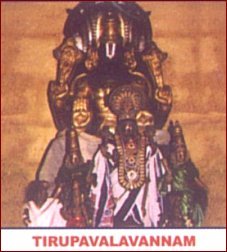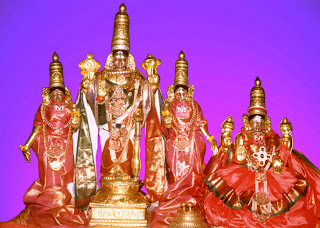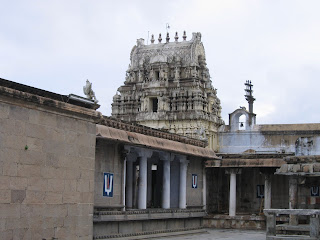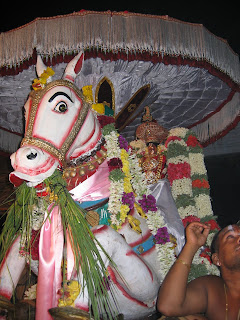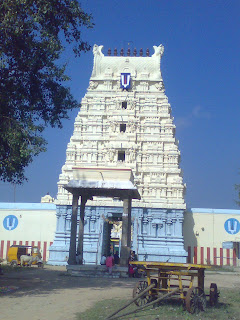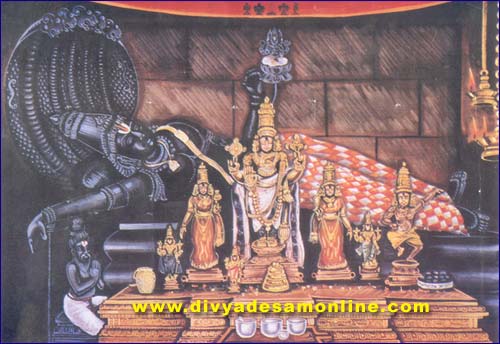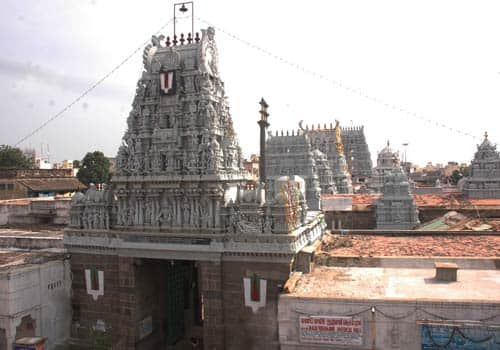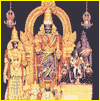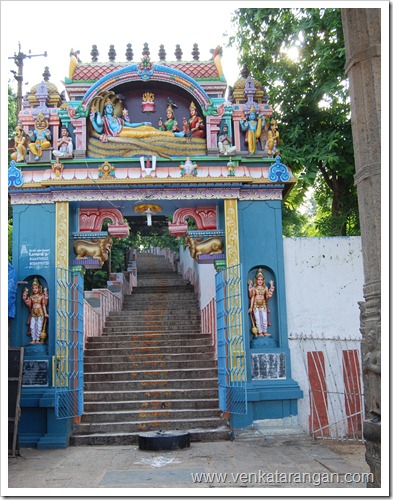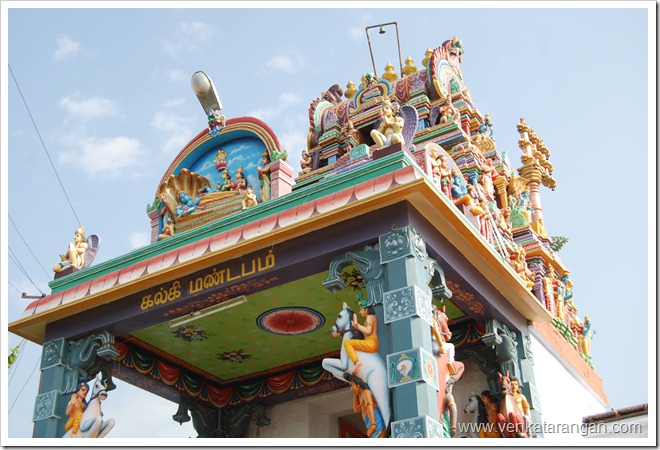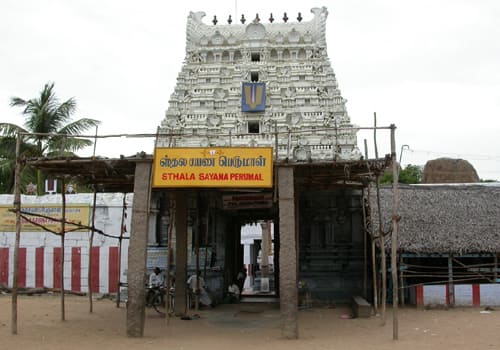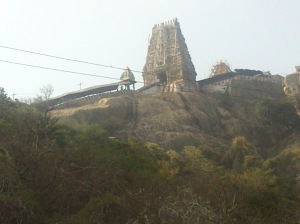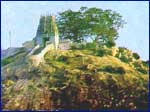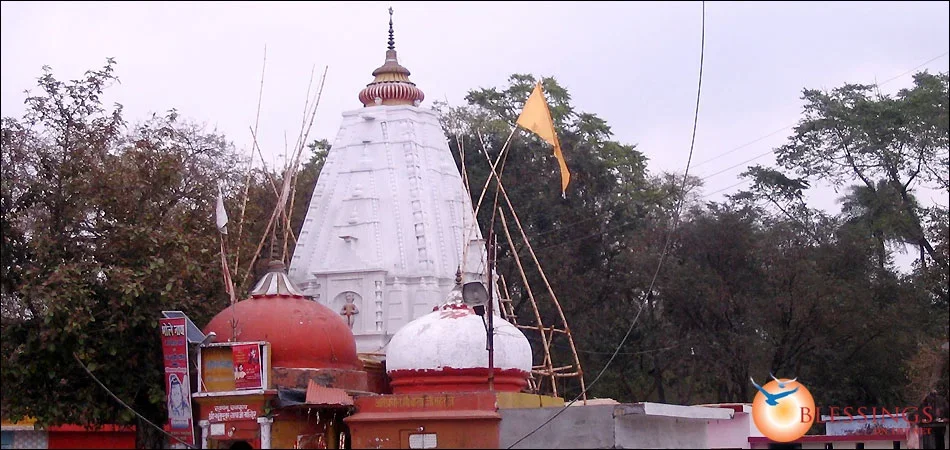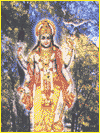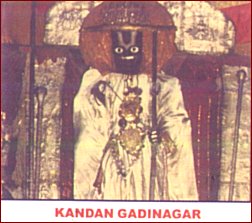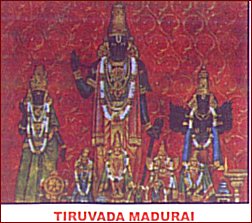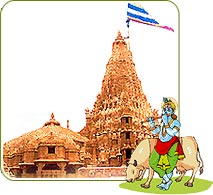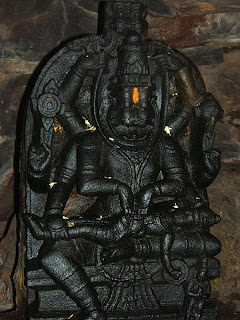Divya Desam 70- Muktinath Temple in Nepal
Divya Desam 70- Muktinath Temple in Nepal
Muktinath is a sacred place both for
Hindus and
Buddhists located in Muktinath Valley at an
altitude of 3,710 meters at the foot of the
Thorong La mountain pass (part of the
Himalayas),
Mustang,
Nepal. The site is close to the village of
Ranipauwa, which sometimes mistakenly is called Muktinath as well.
Within Hinduism, it is called the sacred place
Mukti Kshetra, which literally means the "place of liberation or
moksha". This temple is considered to be the 105th among the available 108
Divya Desam, which are considered sacred by the
Sri Vaishnava sect. The ancient name of this place in
Sri Vaishnava literature, before Buddhist origin, is
Thiru Saligramam. This houses the
Saligrama shila considered to be the naturally available form of Sriman
Narayana - the Hindu Godhead. It is also one of the 51
Shakti peethams. The Buddhists call it
Chumig Gyatsa, which in
Tibetan means 'Hundred Waters'. Although the temple is has a
Vaishnava origin, it is also revered in Buddhism. For Tibetan Buddhists, Muktinath-Chumig Gyatsa is a very important place of
Dakinis, goddesses known as Sky Dancers and one of the 24
Tantric places. They understand the
murti to be a manifestation of
Avalokitesvara.
Legend
The Tibetan Buddhist tradition states that for this reason Guru Rinpoche, also known as
Padmasambhava, the founder of
Tibetan Buddhism, had meditated at Muktinath on his way to
Tibet. This temple is praised by many saints of
Hindu tradition. The scripts narrating the importance of this temple is available in
Vishnu Purana with the
Gandaki Mahathmya.
The waterway downstream from Muktinath along Kali Gandaki is the source of all
Silas or
Shaligrams that are required to establish a temple of
Vishnu anywhere in the world. It is considered to be one of the holiest places of pilgrimage for
Hindus and
Buddhists. It has 108 water springs and this number carries great significance in Indian philosophy. An example of the mystery surrounding the number 108, in Hindu astrology, there are mentions of 12 zodiacs (or Rashi) and 9 planets (or Graha), giving a total of 108 combinations. There are also 27 Lunar mansions (or
Nakshatras) which are divided into 4 quarters (or Padas) each giving a combination of 108 Padas in total
Sthalapuranam
The Perumal serves as a "Teacher" (Guru) for himself and thereby explaining the Gnana to the world in 5 different ways.
The characters of (Soul) Aathma.
Character of (Supreme Soul) Paramathma
What the Aathma has to attain.
The ways, to attain it and
The obstacles that are found for the Aathma while its attaining it.
The Perumal, Badrin Narayana explains all these 5 different things known as "Artha Panjaga Gnanam". For a human, 5 relations are the most prominent one. They are Mother, Father, Guru, God and the pre generation persons known as Pithru. In this, Guru is so important and it is non - equivalent to anything. Without a proper guidance from a Guru, one cannot attain anything. So, the perumal here serves as the guru and explain the Wisdom - Gnana to the world.
As the same way, the perumal is born as both Naran and Narayanan and he gives the seva to both Naran and Narayanan and he gives the seva to Naran thereby explaining the Gnanam towards him.
While going towards Badrinath, one can enjoy the visit and get the seva of Perumals in Haridwar, VishnupAdham, Thiriveni Sangamam, Rishikesh, Deva Prayag, Kandam (Kadinagar), Rudra Prayag, Karna Prayag, Nandha Prayag, Joshi mutt, Hanuman Chatti, Bramagha dam, Taptha Kundam and Simha Dwaram.
Badrinath is 10,380 feet above from the sea level. Bhaktas who travel Badrinath, first should visit Brahma Kundam (theertham) in Haridwar, where bhaktas take a spiritual bath in that theertham before going to Badrinath. This place is also called as "Vishnu PAdhm" (Foot prints of Sri Maha Vishnu).
From here, we can see the Ganga river originating. It is said that river Ganga originates from the thiruvadi (feet) of Sri Vishnu. The Dwaram (the small entrance (or) hole) from where the Ganga river originates is said to be Haridwar. People get this Ganga water in a closed vessel containers and take to their homes and keep them as sacred. Haridwar is called as "Kapilasthan", because Kapila Munivar did the tapas here and worshipped Goddess Maya and because of this, the place is also called as "Mayapuri". There are temples for Goddess Manasa Devi, Chandi Devi, Maya Devi, Anjani Devi, Neeleshwar, Dattatreya, Navagrahas, Mahadeva and Mrithyunjaya Mahadeva.
Lots of Ashrams are found. Some of them are Kailasha Ashram dedicated to Aadhi Sankarar, Sri Vananda Ashram started by Swami Sivanandar, Gita Ashram, Swarga Ashram, Paramathma Niketan.
Badrinath is said to be one among the great Dhamas (holy Shrines). Other great Dhamas are Rameswaram, Dwaraka and Jagannath. There are 5 Badris namely Vishal Badri, Dhayana Badri, Yoga Badri, Vridha Badri and Bhavishya Badri and five prayags are Devaprayag, Rudra prayag, Karnaprayag, Nandaprayag and Vishnu prayag.
Devaprayag:
This is the place where the Alaknanda and Bagirthi rivers mingle to one another and the river falls down as "Aadhi Ganga", In Devaprayag, Brahma deva, King Dasaratha and Sri Rama are believed to have done tapas. And a Mutt is installed by Aadhi Sankara here.
Rudraprayag:
Rudraprayag is the place where river Mandakini joins the Alankananda river. Here a temple for Rudra is situated. Mandakini river rises from Kedarnath and it joins Ganga and then towards Madhya Maheshwar near Gupta Kasi. In Gupta Kasi a famous temple for Ardha Nareeshwarar (half of the body portion representing the Power known as Shakti - Uma and other half as Shiva).
Karnaprayag:
Karnaprayag is the place where Karnan did strong tapas to get all sorts of mantra arrows.
Nandaprayag:
Nandaprayag is the place where the Nandakini river arises and joins Alaknanda. It is said that king Nanda did a severe tapas here in this place.
Vishnuprayag:
It is believed that this is the place where Pandu King did strong tapas towards the Emperumaan Sri Vishnu and it is believed to be the birth place of Panja Pandavas.
Next to Vishnu Prayag is a place called Hanuman Ghat where Lord Hanuman and Bheema met each other. Once, Bheema thought he was the strong person in the world and was traveling along this side. At that time, Hanuman laid there as an old monkey. Bheema say an old monkey lying before him in the path and shouted at the monkey to give way for him. But, the old monkey (Hanuman) told that since he is so weak, he unable to move and requested that if Bheema could move the tail, he can move it and go along with his way. Bheema, not knowing that the Monkey is none other than the so powerful Hanuman, thought he can move the tail with his one hand, but he could not do so. Using his full strength, he tried, but he could not even move the tail for an inch. Finally, he thought, the old monkey might be some Demon known as Arakkan (or) Magician. But finally, Anjaneya revealed his original posture (Roopam) and explains him that they are brothers (since both them are sons of Lord Air known as Vaayu). Bheema fell to the feet of Sri Anjaneya and asked that he should be along with them during the war against the Gauravas (Duriyodhanan and his troop). Sri Anjaneya told that he will be along with them in the flag which is on top of the Chariot of Arjuna.
Since, Naran and Narayanan came to this sthalam, two mountains on the names of them are found. The Nara Parvatham (mountain) is on the Eastern bank of Alknanda river and Narayana parvatham on the west bank of Alknanda river. These two mountains are almost covered by snow, in all times.
Nara Parvatham is also called as Kubera Bhandar since lots of precious gems and diamonds are found on its glaciers. Once, there lived an arakkan (demon) by name "Sahasrakavacha", who gave lots of trouble for the Rishis and yogis. All of them prayed towards the perumal to save them out from the Demon. At that time, both Naran and Narayanan did tapas towards the perumal. On hearing that these two persons were doing severe tapas towards the Emperumaan, Sahasrakavachan rushed towards them to kill them. Both, Naran and Narayanan fought strongly with the demon and finally killed him. Thus, they permanently stayed in Badrinath to save all the Rishis and Yogis from all the demons.
About 5 miles away from Badrinath, is a place known as "Dharma Shila". It is believed that in this place, Dharma Rajan and his wife Kala did tapas towards the Lord Sri MahaVishnu. As a boon from the Lord, Dharma Raja and his wife asked that the Lord should also be along with them and that's the reason why Dharma shila is found near Badrinath.
Tapta Kund:
This tapta Kund situated in between the temple (Badrinarayanan) and Alaknanda river. Despite being so cold and lots of snow falls, this tapta kund excretes hot water (springs) which is said to be a special one. It is said that the Ganga river after coming from the Divine Feet of Sriman Narayana is beared by the Lord Shivaperuman's head and since it comes out form the hot and from Kabhala of Shiva, it is said the water of Tapta kund is hotter.
After taking bath in tapta kund, devotees to climb some steps upwards to worship Garudalwar. After worshipping him, we can reach the pragaram. The place is known as 'Simh Dwaram' where Garudalwar statue is situated..
In front of Badrinath temple, the Nara and Narayanan mountain are located. Inside the temple, Lord Sri Badrinarayana in sitting position which is termed as "Padmasana" pose. On his left is Naran and Narayana and to his right, Kubera with his face adorned in silver. Narada Maharishi is also there along with them. A Sudharsana Chakkaram (A power of Wheel in Lord's right hand) to spiritualise the kshetram. The Utsavar is Uddhava and in front of him is a small Garudalwar statue.
It is said that a big date tree (Elandhai) is covering the Badrinarayana temple and it will not be visible to any person in Kali yugha. The tree is said to symbolize Sri Mahalakshmi and she is protecting Badrinarayana from cold by covering him.
Moolavar and his Sannadhi:
The Moolavar Badrinarayana is said to be made of Salagramam. He is along with Aravindhavalli thaayar, Garuda, Kubera, Naradha, Utthavar, Devarishi and Narayana. He is in sitting pose and has 4 hands. His left hand holds the Sangu the Conch and in his right hand hold the Wheel the chakkaram and lifted upwards and remaining two hands are joined together and found as Yoga mudra and Abhaya Varadhan.
Devotees can get the darshan of this Lord, without any time restriction they can spend here and Holy bath to Lord known as Thirumanjanam, offering of eatables etc are done in the presence of the devotees.
Thaayar and her Sannadhi:
On the south pragharam of the temple is the sannadhi for Aravindhavalli thaayar is situated and She is called as "Mahalakshmi". On the west side, Aadhi sankara sannadhi and behind the temple, Lakshmi Narasimha Mandir and Sannadhis for Sri Swami Desikar, Udayavar Ramanujar are located.
On the north side of the temple on the bank of River Ganges, a big rock named "Brahma Gobalam"; it is believed that if we dedicate Pindam (a ball made of rice) here for the departed souls known as Pithrus, for the next 14 generations people are said to go to heaven and Moksha. And if done once, thereafter, if one perform this once, there is no need to do the annual ritual for the departed souls that is known as Shrardham.
Moolavar:
The Moolavar of Badrinath Kshetram is Badri Narayanan. He is in sitting posture (Irundha thirukkolam) facing east Prathyaksham for Naran.
Thaayar:
The Thaayar in this Kshetram is Aravindhavalli.
Mangalasasanam:
Periyalwar - 1 Paasuram.
Thirumangai Alwar - 21 Paasurams.
Pushkarani:
Tapta Kundam.
Sthala Viruksham (Tree):
Badri Viruksham (Date tree).
Vimaanam:
Tapta Kanjana Vimaanam.
OM NAMO NARAYANA
https://www.trsiyengar.com/id261.shtml
http://www.thehindu.com/thehindu/fr/2003/08/22/stories/2003082201650600.htm
https://en.wikipedia.org/wiki/Divya_Desam
https://en.wikipedia.org/wiki/Muktinath
http://www.muktinath.org/muktinath/
http://www.thehindu.com/thehindu/fr/2003/08/22/stories/2003082201650600.htm
